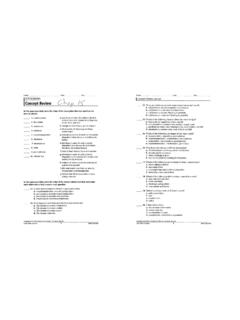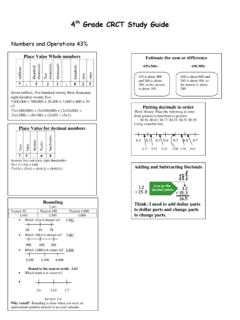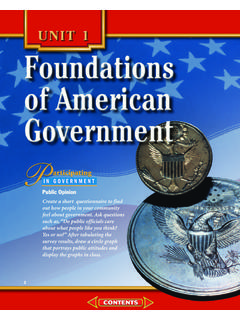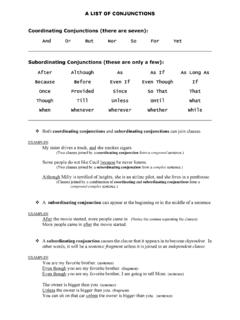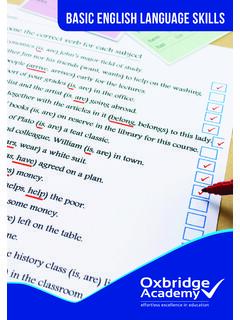Transcription of 5th Grade Figurative Language - Henry County Schools
1 5th Grade Figurative Language Alliteration Alliteration is the repetition of a consonant sound at the beginning of words. Examples: The sweet smell of success It s now or never Simile A comparison between two unlike things that have something in common is called a simile. A simile always uses the words like or as to make a comparison. Examples: Paul Bunyan was as strong as an ox. The forest was as quiet as a falling leaf. Metaphor A metaphor is a figure of speech comparing two unlike things that have something in common. The comparison is made without the use of like or as. Examples: My voice was a cannon breaking the silence. Her hair was silk. Personification Personification is giving human traits (qualities, feelings, action, or characteristics) to non-living objects (things, colors, qualities, or ideas). Examples: The sun smiled at me as it popped up.
2 The rain kissed my cheeks as it fell. 5th Grade Figurative Language Hyperbole Hyperbole is exaggeration. It puts a picture into the "reader" mind. Hyperbole is frequently used in humorous writing. Examples: I nearly died laughing. I tried a thousand times. Imagery To make an imaginary world seem real, an author often makes use of words and phrases that appeal to the senses. These words and phrases, called images help a reader mentally experience what the characters in the literary selection are actually experiencing. Sight-orange glare, green meadows, wilted and dry willows Smell-dusty odor of the dry Earth Taste-a tall frosted glass of lemonade, the bland taste of starchy bananas Sound-crackling underbrush Touch-hot July sun, damp jeans, tepid water Onomatopoeia The use of words to imitate sounds is called onomatopoeia. Examples: Bang, pop, hiss, and sizzle 5th Grade Figurative Language Idioms An idiom or idiomatic expression refers to a construction or expression in one Language that cannot be matched or directly translated word-for-word in another Language .
3 It is not literal. Examples: She is green with envy. It s a piece of cake. Puns A Pun is the humorous use of a word or words, which are formed or sounded alike but have different meanings, in such a way as to play on two or more of the possible applications; a play on words Examples: I used to be a transplant surgeon, but my heart just wasn't in it. What did the toy store sign say? Don't feed the animals. They are already stuffed. Palindromes Palindromes are words or phrases which read the same backwards as forwards. Examples: Racecar go dog Was it a car or a cat I saw? 5th Grade Story Elements Setting The setting of a story is the place where the story happens and the time when it happens. The setting answers the questions of where and when. The setting doesn t have to be a real time and place.
4 It can be imaginary, like the island, Never land, in the story of Peter Pan. Character Every person or animal who takes part in the action of a story, poem or play is called a character. The most important characters are called major characters. Everyone else is a minor character. Character Traits A quality that a character exhibits is called a character trait. This trait can be indicated by the character's statements, actions, or thoughts. 5th Grade Story Elements Conflict in Plot The plot is what happens, concretely, as though it were placed on a history time line. Conflict is essential to plot. Without conflict there is no plot. It is the opposition of forces which ties one incident to another and makes the plot move. Theme Theme is the life lesson, meaning, moral, or message about life or human nature that is communicating by a literary work.
5 Themes are not explicit (clearly stated). Themes are bigger than the story. Dialogue Dialogue is a discussion or conversation between two or more characters. 5th Grade Dramatic Literature Cast of Characters A list of the characters in the play with a short description of each. Scenes A subdivision of an act in a dramatic presentation in which the setting is fixed and the time continuous. Acts A large division of a full-length play, separated from the other act or acts by an intermission Stage Directions The writer's instructions for performing the play. They tell actors how to move or deliver lines. They also describe the stage set, costumes, and props. In the written version of a play, stage directions are often printed in italics. Poetry Stanza Two or more lines of poetry that together form one of the divisions of a poem. The stanzas of a poem are usually of the same length and follow the same pattern of meter and rhyme Rhyme Rhyme is the similarity in sound of the ends of words: the last stressed syllable and the following unstressed syllables (if any).
6 Rhyme is usually a structuring device in verse. Rhyme Scheme When rhyming verses are arranged into stanzas, we can identify the rhyme scheme by assigning letters each rhyme, beginning with a and proceeding through the alphabet. Example: aa bb Refrain A line or group of lines that is repeated throughout a poem, usually after every stanza 5th Grade Organizational Structures Chronological Order Chronological order presents ideas according to the time in which they occurred. This type of organization is especially effective if you are describing a process, relaying a series of actions, or telling a story. For instance, to convey the plot of a novel or the procedures of an experiment, you would tell readers what happened first, second, etc. Logical Order Logical order is the most common method of organizing your written thoughts in an essays. When you use this method you group related ideas together and discuss each group, one after the other.
7 Therefore remember to group your ideas into common groups and this will help your writing coherence Cause and Effect Cause is something that makes something else happen. Out of two events, it is the event that happens first. To determine the cause, ask the question "Why Did it Happen?" An effect is what happens as a result of the cause. Of two related events, it s the one that happens second or last. To determine the effect, ask the question "What Happened?" 5th Grade Vocabulary Acquisition Root Word Root word is a word that has nothing added at the beginning or the end. It stands on its own as a word, it has a meaning. New words can be made from root words by adding beginnings (prefixes) and endings (suffixes). Prefix A prefix is a group of letters which you can add to the beginning of a root word* to change the meaning of the word. mis + fortune = misfortune Prefix Meaning mis means 'wrong' or 'badly' sub means under pre means 'before in time', 'in front of' or 'superior' un means not (there are also several other prefixes which mean not) Suffix A suffix is a word ending.
8 It is a group of letters you can add to the end of a root word* walking, helpful Suffix Example ed walk + ed = walked ing say + ing = saying er tall + er = taller tion educate + tion = education sion divide + sion = division fully hope + fully = hopefully est large + est = largest 5th Grade Vocabulary Acquisition Antonym a word opposite in meaning to another. Fast is an antonym of slow. Synonym a word having the same or nearly the same meaning as another in the Language , as joyful, elated, glad. Homophone a word pronounced the same as another but differing in meaning, whether spelled the same way or not, as heir and air. 5th Grade Conventions Type of Sentence Use Punctuation Mark Declarative Makes a statement Period ( . ) Interrogative Asks a question Question Mark ( ? ) Imperative Gives a command or makes a request Period (.)
9 Exclamatory Expresses strong feeling Exclamation Mark ( ! ) 5th Grade Conventions Fragments A sentence fragment is an incomplete sentence. Some fragments are incomplete because they lack either a subject or a verb, or both. Dependent clauses they have a subject and a verb, so they look like complete sentences, but they don't express a complete thought. Examples: Because his car was in the shop After the rain stops When you finally take the test Run-ons You are making a run-on when you put two complete sentences (a subject and its predicate and another subject and its predicate) together in one sentence without separating them properly.
10 Example: My favorite Mediterranean spread is hummus it is very garlicky. Modifier A modifier can be an adjective, an adverb, or a phrase or clause acting as an adjective or adverb In every case, the basic principle is the same: the modifier adds information to another element in the sentence. Verb Tenses An action which indicated a time of occurrence Past: Already happened Present: Is currently happening Future: Will happen in the future 5th Grade Conventions SIMPLE SENTENCE A simple sentence, also called an independent clause, contains a subject and a verb, and it expresses a complete thought. Examples: Some students like to study in the mornings.


